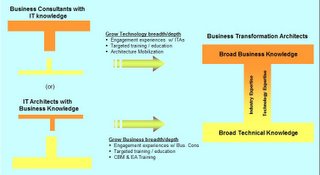I received a great presentation the other day entitled “Four Crises for Business: Time, Talent, Trust, and Transformation” by Peter Andrews at the IBM Executive Business Institute. While this is not exactly an I/T Architecture issue, I think the issues he brings out will show up in the business drivers and business requirements of our I/T projects. We're certainly affected by the these issues in our work environment.
With his permission, I will share a few quotes from his work that I think will resonate with I/T architects.
At a high level, there are no surprises. Executives have been putting the challenges of globalization, cost-cutting, disaster planning, shortened product lifecycles and attracting and retaining the best employees onto their top ten lists for years. Politics, the world economy, technological advances, investor impatience, natural disasters and other drivers of change have been pushing business hard for decades. Once mighty companies have lost their footing, and many have fallen....
Everyone is working harder, but are we doing anything differently? Are radical changes in direction even considered?”....
Consider four crises that thematically sum up our difficult times, and then consider what might be done about each:
The Crisis of Time. Douglas Adams said, “I love deadlines. I love the whooshing noise they make as they go by.” Most of us have far too many deadlines whooshing by and it doesn’t inspire feelings of affection. Take a poll of your team and see how many of them feel like their task lists are longer and someone has been stealing minutes, if no hours, from their clocks.”....
....progress in interruption management systems are all on the way to help. Think of the effort your business puts into cost cutting and see if you can do the same thing for time cutting – at the level of individuals, as well as teams. But first, think wisely about what you and your colleagues will do with the time savings, and hold onto the time for those purposes. Even if those purposes include taking a deep breath or daydreaming.”
The Crisis of Talent. “Great people make a great company ..... But there aren’t enough great people to go around and we don’t use them well. Part of the problem is scheduling (as can be seen in the Crisis of Time), but part of it is just finding and training them. How do we know who the great people are when our measurements have been reduced to revenue numbers? How do we expose and develop talent when training is just a cost number? How do we get talented people involved in the right projects? How do we keep talented people engaged and motivated? How do we keep them at all?....
And don’t forget training, which may need to take on new characteristics as those who have learned as much from online multiplayer games than from classroom instruction begin to enter the workforce. ....
The Crisis of Trust.
Half of all strategic business relationships fail to meet their objectives, .... Confidence in management is dropping. In a survey of 13,000 employees at U.S. companies, Watson Wyatt Worldwide found only 39 percent trust their senior leaders. And every time a deadline is missed or an offhand comment is misconstrued, a virtual team starts to strain its seams....
And yet, eBay, where most buyers and sellers never meet face-to-face, has an estimated US$23 billion worth of transactions each year. This is possible because the company provides over a dozen trust enabling/establishing services, including security, payment escrow, user agreements, a privacy policy and, most importantly, the input of peers. Feedback, stars, rating the raters – it’s all part of a reputation management system that allows the community to vouch for the individual. Similar clusters of technologies can provide a basis for trust across the organization (and, not incidentally, give your team access to talented unknowns).
The Crisis of Transformation.
You can’t anticipate everything, but you have to be ready for anything. Scenario planning and good backup systems can help with disasters, of course. But flexibility will be demanded of almost all businesses in a world where global outsourcing breaks down barriers and shifts value, where challenging regulations like Sarbanes-Oxley in the U.S. require more accountability, where the viability of channels changes and the ability of companies to cluster into well-positioned virtual corporations creates new, vital competitors....
Intriqued? Check out Peter Andrews' class on Business Futures at the Executive Business Institute... and take your C-Level with you.
Some of my more random thoughts on this. That means don't blame Peter if you disagree me on this. :-)
- I am certainly a victim of “time-cutting”, time wasting, and interruptions. I bet you are too.
- I wonder what the cure is. Will it be “interruption management” systems? Part of me would like to go back to the days when someone in my position had a secretary. A real person who would run interference for me. But, realistically that is nostalgia. I can’t envision that scenario happening. I also wonder if I’m culturally ready to turn over my calendar, phone, email, etc. to an electronic secretary with a mission to keep me from being interrupted.
- Will companies start measuring how interrupted their employees are? Will we be getting software requirements for those interruption management systems in the near future to try to squeeze more hours of productivity out of employees? I wonder if I could articulate the benefits of such a system to someone who actually had budget authority to fund it?
- “Training is just a cost number” More nostalgia. I remember when I was almost expected to go into an online catalog of training classes in various cities across the country and pick a couple classes a year. These were real classes in nice facilities in nice cities with real teachers and real labs and real whiteboards. Those were the days! Now they want us to do everything in some kind of virtual classroom via the internet. Airfare and hotel ? Forget it! And why do I, a person who makes his living on computers, hate the idea of a virtual classroom. I kind of like chatting with the other students on breaks and over lunch. I learn something there too. Is there a way to at least partially reproduce this under today's cost constraints?
- Undiscovered talent / Un-Nurtured Talent - As a senior I/T Architect it is part of my job to develop talent. In the consulting business this is viewed as increasing our capacity to deliver solutions to our clients. Frankly, as I practice it today it is more gut instinct, Golden Rule, and taking advantage of mentoring opportunities as they present themselves. Is this enough? What if I don’t meet those programmers working in romote places face-to-face and don’t have impromptu white boards sessions? What if the time of day that I am all energized and in the mood to play coach and mentor, those remote programmers have already been working all day on their timezone and want to go home?
- Trust - Here I can see some real business requirements and some real value. Imagine looking to see how many stars someone has earned before deciding to use them on your project. Would I really take a “talented unknown” on the basis of their intranet “star rating”? Imagine looking to see how many stars a boss has before accepting a position. Imagine if I could earn a bonus from my stars! And how do we prevent everyone giving each other good grades and the resulting “trust inflation” because nobody wants to be the bad guy.
- Transformation - I am reminded of all the process choreography discussion that goes on around Service-Oriented Architecture (SOA). Imagine all those ovals on the whiteboard with service names inside them. Imagine if there were really readily available providers for all those ovals. The company would only exist to wire together or choreograph the process, consisting of these services.
- Could I make more money selling process choreography software?
- If this is for real, how many of us I/T Architects are going to quit our jobs and become entrepreneurs? Anybody ready to create your own company to provide one of these easily plugable services? Want to be in the business of providing the service in one of those ovals on the whiteboard?
The postings on this site are my own and don't necessarily represent IBM's positions, strategies, or opinions.



